WARREN
CRISWELL, ANXIOUS REALIST
By Peter Frank |
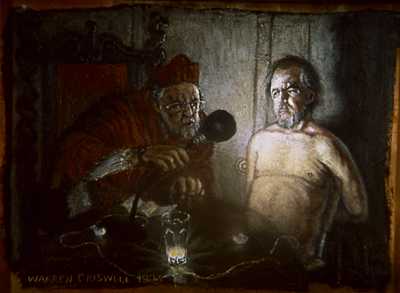
The Question, 1993, oil on copper, 5 x 7 inches. Collection
of Rickey Medlock
Warren
Criswell's painting - and his drawing and printmaking no less
- troubles the waters of contemporary artistic discourse. Criswell's
work proposes that an entirely backward-looking stylistic approach
can act as a vehicle for entirely timely thoughts and sensations.
Furthermore, although supported by the post-modernist argument,
which encourages us not to dismiss an art such as Criswell's
out of hand, his work does not rely on the conceptual dodges
and self-conscious anachronisms we associate with post-modern
practice. While Criswell's subject matter brims with the passions
and disturbances of early 21st century life, it does not place
itself at a dissonant, ironic angle to his entirely realist manner
or technique. Rather, that manner, so thoroughly rooted in the
late 19th century, and that technique, based on examples from
the 16th (late Titian) and 17th (Rembrandt in particular), proves
its durability and suppleness in Criswell's hands, serving as
a graceful and powerful vehicle for the artist's sweeping narrative
focus.
|
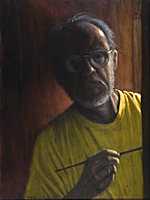
Man in a Yellow Shirt,
2002, oil on linen, 24 x 18 inches |
Over
the past two hundred years the narrative impulse has risen and
fallen repeatedly throughout artistic practice. Considering that
those two centuries have been dominated by powerfully persuasive
communication technologies such as photography, cinema and television,
it is no surprise that the discourses in more traditional media
- themselves transformed by the liberating possibilities of abstraction
- have wrestled with the narrative "question". The
narrative is about the most provocative tradition in western
art; as such, its profoundly uneasy condition in contemporary
artistic practice - its relation to the novel, to theater, to
film, and also to less exalted, even kitschy aspects of visual
culture such as illustration and comic strips - only amplifies
its ability to engage us on a variety of levels. |
Many contemporary narrative painters
working in the United States exploit this newfound multivalence,
not only mastering the formal and physical obduracies of traditional
artistic media in order to meet the demands of pictorial storytelling,
but developing a narrative practice whose peculiarities root
it in those media. They have developed a not-quite-surrealism
- an imagery loaded with idiosyncrasies derived from and dependent
on the tones and textures of paint on canvas, pencil on paper,
and even ink on plate or block - whose distortions of quotidian
reality mirror (or anticipate) the slippages in perception to
which we inhabitants of a complex and uncertain world are subject.
If the ideologies of the Modernist era provided at least the
projection of certainty onto a tumultuous civilization, the sociopolitical
disillusion of the last half-century has left us without such
psychological safety nets. (No wonder that so many people around
the world now resort to religious fundamentalism - or that their
fervency has now become one of the principal sources of the world's
political, and spiritual, destabilization.) The "anxious
realism" of these American artists embodies our cognitive,
even somatic, free fall. Nothing is quite what it seems - nor,
as the Zen koan goes, is it otherwise. |
Anxious Realists are at work all around the United
States, some contravening the dominant artistic discourse in
major art centers, others taking advantage of their removal from
such centers, still others responding to regional artistic environments
and traditions. Although Anxious Realism answers to a countrywide
malaise - a new age of anxiety in which the monsters under the
bed seem more potent and less placable than ever - it invariably
reflects local attitudes and circumstances. This would suggest
that the American Southeast, vaunted as a hotbed of narrative
expression and homegrown surrealism, would be especially hospitable
to Anxious Realism.
It's thus not surprising to find that the state of Arkansas alone
boasts one of America's best known and most extravagant Anxious
Realists, Donald Roller Wilson, as well as one of the subtlest,
Warren Criswell. The literary impulses of both Roller Wilson
and Criswell are quite evident, and also quite evidently different.
Roller Wilson transcends the anxiety of his realism with melodramatic
imagery, baroque humor, and an anthropomorphism so attenuated
that it at once mocks and celebrates the dogs-playing-cards tradition
of the "cute." Criswell's imagery may reach similar
levels of unlikelihood, but even his most elaborate fantasies
are rooted in human behavior, in the conventions of seeing, and
in formalized, readily recognizable modes of visual-verbal storytelling
such as theater, film, and opera. If we can think of them as
filmmakers rather than painters, Roller Wilson is an animator
(in many senses of the word), while Criswell directs live people
(although clearly willing to drop in a few special effects where
needed). |
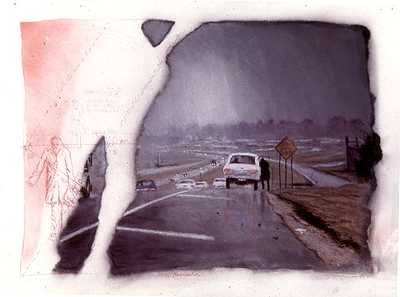 The Navigator, 1987, pastel & spray
enamel on paper, The Navigator, 1987, pastel & spray
enamel on paper,
30 x 40 inches. Arkansas Arts Center Foundation
Purchase: Tabriz Fund, 1988. 87.031 |
What connects the two Arkansans' otherwise
disparate styles so emphatically is their shared lack of irony.
They mean what they paint. Roller Wilson's apparitions, linked
in their staggering narrative arch, are clearly as heartfelt
as they are zany. And Warren Criswell's pictures, whether of
climactic moments in an operatic Gesamtkunstwerk or of strange
and poignant moments in an everyman's life, brim with the same ingenuousness - the same
commitment to this vision and to the sympathetic character of
its protagonists. These painters need to paint these things,
in these ways.
|
|
Criswell's earliest mature work is, not surprisingly,
his most prosaic. Grounded in the conventions of photo-realist
painting, if slightly less dependent on the exact translation
of camera to canvas, his work of the 1970s cleaves to the banality
of the life and lives around him. |
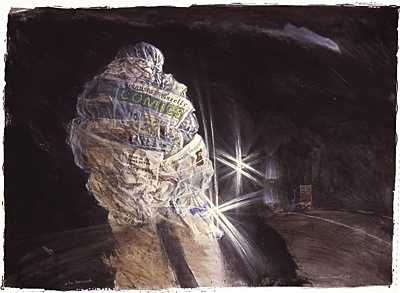
The Open Road,
1988, oiil & pastel on paper,
33 x 45 inches. Collection Arkansas Arts Center Foundation |
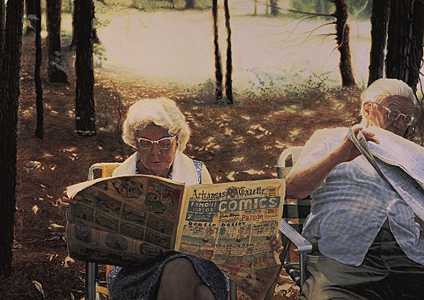
Sunday at Yogi's,
1979, watercolor, 24 x 36 inches.
Collection of Janet Criswell |
That life and those lives would remain Criswell's
principal preoccupation, but as of 1982, he could no longer adhere
to the homey mereness of their surface appearances. Increasingly
painterly in technique and interested in the effects of light
and night, Criswell began to imbue, or at least surround, his
subjects with a preternatural immanence, a glow, lyrical and
ominous by turns, that gave heightened meaning to even the most
mundane of still life subjects. In this magical chiaroscuro,
coins and keys and cups as well as people and buildings and roads
become pregnant with implications, as if props in a drama. |
Continued
1 | 2 | Next>> |
|
|
Warren Criswell
Home Page
The exhibition catalog, Warren Criswell
Shadows, in which this essay appears is Copyright 2003 by
the Arkansas Arts Center
All images and text on this Web site
Copyright © 1997 - present
by Warren Criswell
|



